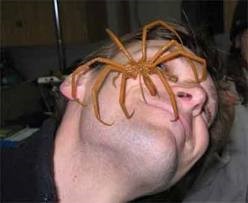About This Project
Anxiety disorders, including phobias, are the most often occurring mental disorders. Mounting evidence points to sleep as an important factor in learning and memory and research suggests that sleep plays a role in phobic-extinguishing. Extinguishing phobias may be learning of new memories rather than the unlearning old ones. This study will compare physiological and behavioral measures of individuals with spider fear in sleep vs. wake conditions after exposure via pictures and virtual reality.
Ask the Scientists
Join The DiscussionWhat is the context of this research?
Under the American Psychiatric Association's Diagnostic and Statistical Manual of Mental Disorders 4th edition criteria, PTSD was considered an anxiety disorder as were specific phobias such as arachnophobia. Due to the prevalence of spider fear in the population, it was determined that those with spider fear would be recruited in the hopes that the results would generalize to PTSD populations. Several researchers have investigated the effects of sleep on extinction and/or habituation. Some studies have focused on sleep, phobic-extinction and behavioral changes regarding spiders. However, the research is largely based on naps rather than a full night of restorative sleep. I believe that there is a gap in the literature that needs to be filled.
What is the significance of this project?
Anxiety disorders are the most often occurring mental disorders, and include generalized anxiety disorders, specific phobias and PTSD. According to the United States Surgeon General, 8% of the adult population is affected by at least one specific phobia over the course of a year. Understanding of anxiety disorders is important due to their high prevalence in the population. Further research in the field benefits psychology as well due to the considerable comorbidity between substance abuse disorders and anxiety disorders. Research suggests that comorbidity with substance abuse disorders is near 50%. Improving the efficacy of exposure therapy could benefit a large portion of our population including veterans.
What are the goals of the project?
Self identifying subjects with mid/high fear of spiders will be recruited for the study and assigned into a sleep or wake condition to be virtually exposed once and then again 12 hours later. Sleep participants will sleep between sessions; the wake condition will not. They will be exposed via virtual reality and photographs to a variety of spiders in increasingly distressing detail. Physiological arousal will be gathered via skin conductance equipment. Emotional arousal will be assessed via self report surveys. At the end of the session, participants will approach 8 jars possibly containing a spider; they will place their hand in a jar for 30 seconds to assess behavior. The funds will be used to purchase virtual reality equipment and pay students for their time.
Budget
Virtual Reality Exposure Therapy has been found to be effective as a therapeutic tool for a wide variety of psychological problems and disorders including PTSD and specific phobias. VRET’s greatest advantage is that it is under direct therapist control and lessens or negates the risk of breaching confidentiality or risking unforeseen exposure. Another advantage of VRET is its ability to make individuals feel present in the virtual environment. VRET participants can be engaged using all five of their senses thus making the simulation seem real. This immersion is what allows the participant to feel active and present within the environment recognizing the environment as meaningful rather than viewing the simulation from a third person perspective.
One hundred participants will be recruited and expected to attend three sessions. To bolster recruitment and limit attrition they will be paid $10 per visit payable after their third or final visit.
Endorsed by
Meet the Team
David Gray
The first suicide I ever saw was a suicide by hanging. I had spoken with the deceased only two days earlier when he unsuccessfully attempted suicide by shooting himself in the chest with a nail gun. In his successful attempt, he tied a rope around the bannister to the basement stairs, walked down the stairs until the rope was taut, and eventually died. I remember wondering what could have made him so distraught that he chose to die when at any point he could have walked back up the stairs and lived. Unfortunately, that was not my last suicide. There were many in my seven years as a police officer. The ages of the victims ranged anywhere from the twelve year old son of a childhood friend to a recently divorced seventy year old.
As helpless as I felt when dealing with suicide victims, I came to realize that I could not help somebody that was already dead, which more often than not was my first contact with the victim. I felt infinitely more helpless when dealing with people that were still alive and suffering from schizophrenia or other psychological disorders. There was literally nothing that I could do within my police training to help the majority of the people with whom I had contact. From my own experience, police officers come into frequent contact with the mentally ill and are woefully unprepared and lack the training to deal with serious mental disturbances. Life circumstances changed and I found myself able to go back to school. Based on the experiences that I had as a police officer, and the number of years I spent as either a military member or a civilian working in support of the military in the USA, Europe, and Asia, I chose to pursue a degree in psychology. As an Air Force veteran and former first responder, these populations are whom I care about most deeply. My research is based on finding more efficacious treatment for this population after experiencing trauma at work.
Additional Information





Pictures to be used during the desensitization phase will be taken from the internet, and depict spiders. The pictures will be arranged in a hierarchy based on distance (far to near), and culminating with contact with humans. There will be five sets with four pictures each. The purpose is to increase the “repulsiveness” of the feared stimuli over the course of the exposure with the expectation of increased arousal in participants with mid to high levels of spider fear.
Project Backers
- 5Backers
- 7%Funded
- $310Total Donations
- $62.00Average Donation

